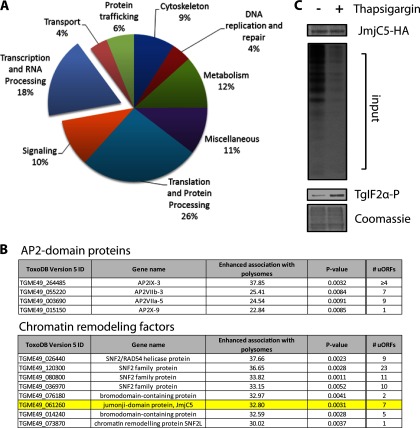Fig 5.
Subset of transcriptional regulators is suggested to be preferentially translated in response to ER stress. (A) Pie chart displays GO categories of genes that were suggested to be preferentially translated following treatment with tunicamycin (P < 0.02). (B) A list of preferentially translated AP2 factors and chromatin remodeling factors that are suggested to be preferentially translated during ER stress. The chart indicates enhanced association with polysomes (percent shift to polysome fraction) following tunicamycin treatment and the predicted number of uORFs within the 5′-UTR of each preferentially translated mRNA. (C) Parasites were subjected to ER stress by treatment with 10 μM thapsigargin or control vehicle (DMSO) and incubated with [35S]Met/Cys to radiolabel the synthesized proteins in each sample for 90 min. Two percent of each sample (input) was resolved by SDS-PAGE, followed by autoradiography (second panel from top). Coomassie blue staining indicated equal loading of input protein between the DMSO- and thapsigargin-treated samples (bottom panel). JmjC5-HA was immunoprecipitated from each lysate using anti-HA-coupled agarose beads and subjected to autoradiography after being resolved by SDS-PAGE (top panel). Immunoblotting with antibodies that specifically recognize TgIF2α phosphorylated at Ser-71 (TgIF2α-P) was performed to confirm induction of ER stress by thapsigargin treatment (third panel from the top).

